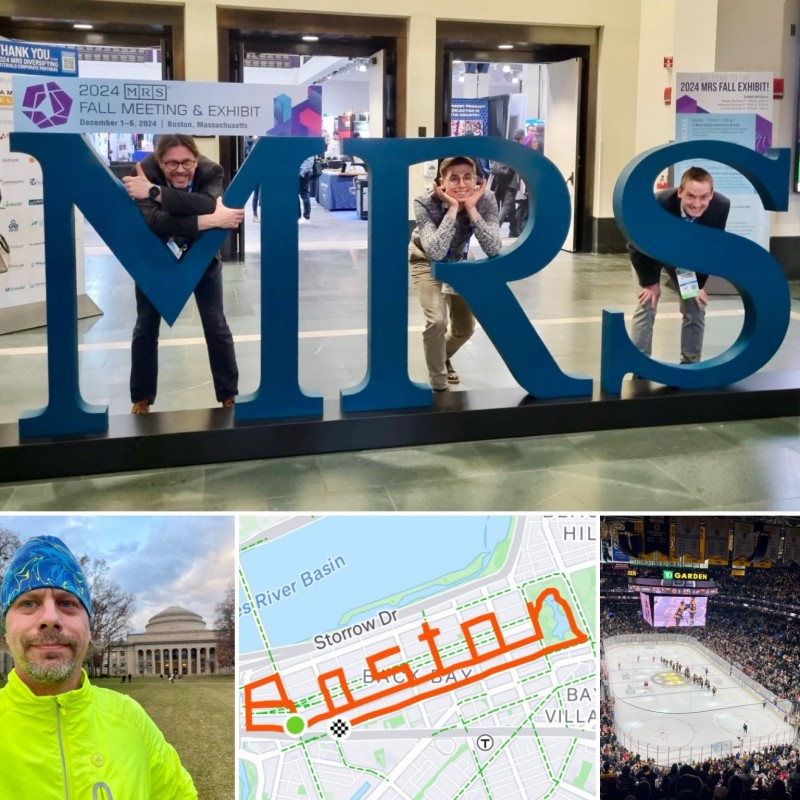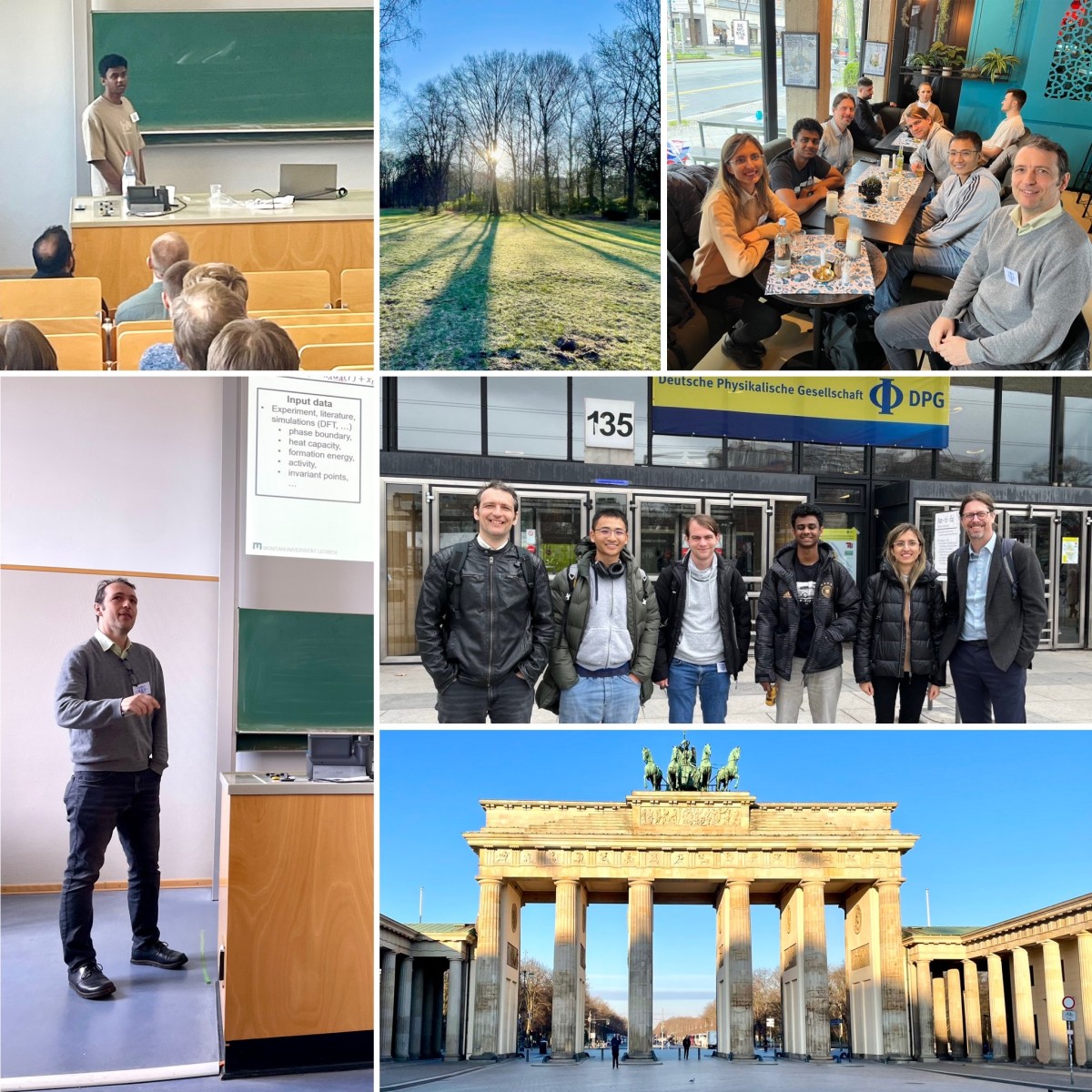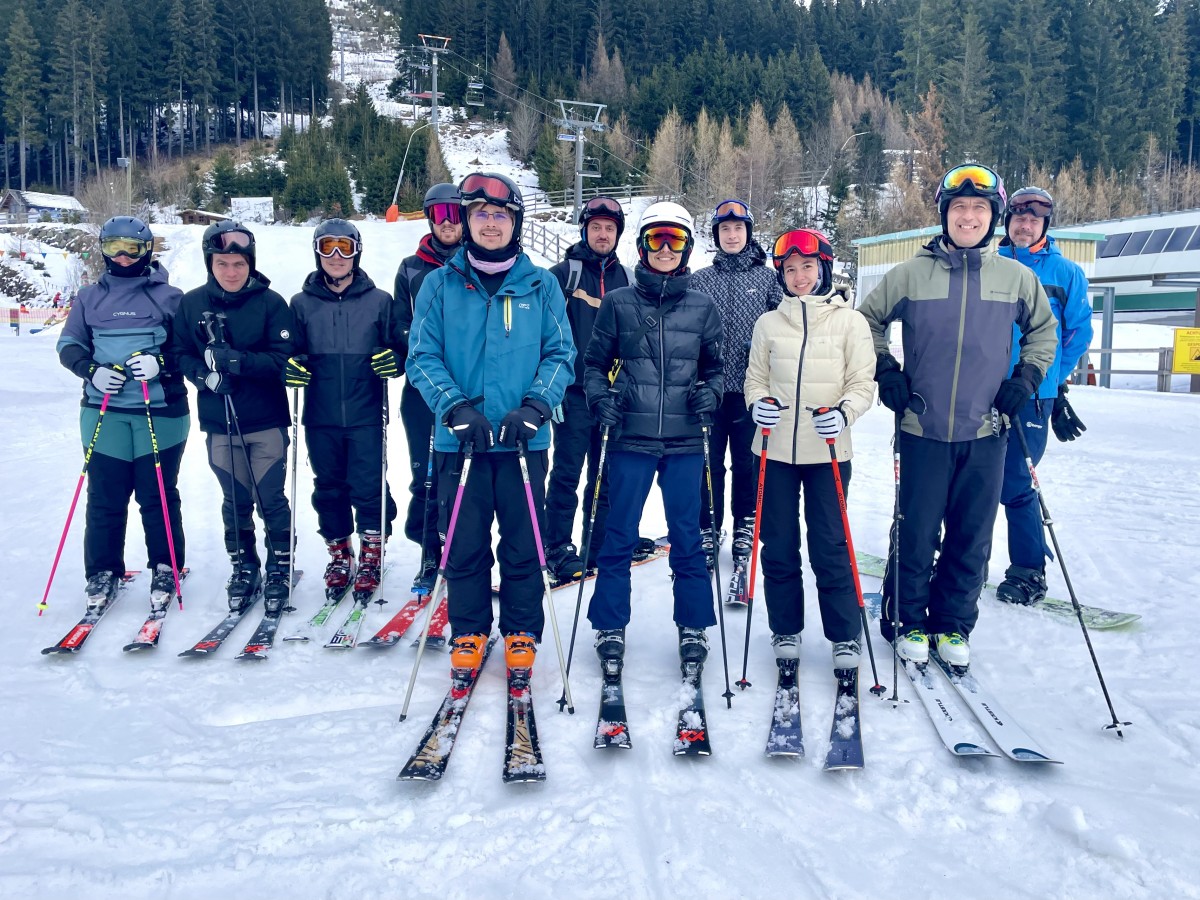
David had a busy week at the MRS 2024 Fall Meeting in Boston. Why busy?
He attended exciting and inspiring lectures for five consecutive days. In particular in the SF05 symposium, he met many friends and colleagues, and was delighted to deliver an invited talk. He found time to go for a jog - his very first StreetArt run. And visited hisvery first NHL game.
In his invited lecture he reviewed our recent modelling activities on phase transformations in intermetallic (NiTi, TiAl) and Ti alloys. The last topic is related to an FFG funded project T3Design, a nice collaboration with Thomas Klein and José Neves.

Using density functional theory, we investigate whether alloying or spatial confinement can suppress the magnetic moments of Cr to stabilise a non-magnetic (NM) phase, which has been predicted to exhibit interesting mechanical properties. However, our results show that the moments remain robust regardless of alloying elements or superlattice configurations. This confirms that NM-CrN remains a purely theoretical construct, as material design is unlikely to induce its stabilisation.
The initial idea for this paper arose through discussions with Paul Mayrhofer (TU Wien, AT).
M. Matas, P.H. Mayrhofer, D. Holec: "Magnetic moments in CrN-based systems are robust: An ab initio study of alloys and superlattices". Surf. Coat. Technol., 496(131540), 131540 (2025). DOI: 10.1016/j.surfcoat.2024.131540
David attended the 11th Conference on Multiscale Materials Modelling (MMM11) in Prague and presented the work on segregation in compositionally complex alloy done by Dominik. The Big CMS group from Leoben was well represented in Prague with another seven colleagues!
Using a combination of synchrotron measurements, electron microscopy, DFT and FEM simulations, we identified a novel hydride phase formed in NiTi shape mamery alloy during charding with hydrogen.
This is an international collaboration of several research groups and was coordinated by Antonín Dlouhý from IPM, Brno, Czechia.
A. Weiser, J. Todt, J. Holcova, T. Zalezak, A.M. Paulik, D. Holec, M. Jary, O. Zobac, J. Mrazek, J. Frenzel, J. Keckes, A. Dlouhy: "Hydrogen penetration into the NiTi superelastic alloy investigated in-situ by synchrotron diffraction experiments". Acta Mater., 277(120217), 120217 (2024). DOI: 10.1016/j.actamat.2024.120217
What summer would it be without a traditional informal summer bbq. This year also with several formal group membes!

Ganesh performed DFT calculations revealing the impact of Si and vacancy content on the lattice parameter of TiSiN. Using them we could show that vacancies play only subordinate role for reaching the range of the measured lattice parameters, hence highlighting the primary impact of the Si content. The paper also present a comprehensive microstructural investigration of the TiSiN coatings.
This work resulted from an internal collaboration with the group of Nina Schalk and Michael Tkadletz.
N. Schalk, Y. Moritz, G. Nayak, D. Holec, C. Hugenschmidt, V. Burwitz, L. Mathes, M. Schiester, C. Saringer, C. Czettl, M. Pohler, C. Mitterer, M. Tkadletz: "Nanocomposite versus solid solution formation in the TiSiN system". Acta Mater., 275, 120063 (2024). DOI: 10.1016/j.actamat.2024.120063
Amin and David attended the International Conference of Chemists and Chemical Engineers of Bosnia and Herzegovina. Amin reported about his study of impact of tramp and trace elements on reversible temper embrittlement in steels, while David spoke about the hydrogen storage research. In addition to interesting scientific meeting, we could enjoy (again!) the local hospitality and absorb some of the vibrations of Sarajevo!
Despite the bad weather, we left the comfort of our offices, disconnected from the internet, and replaced tablets with paper and pencils. On an old remote barn with almost no cell phone reception, we engaged for a full day in scientific and organizational discussions, planning our activities for the near future. Great things are in the line, stay tuned ;-)

Have you ever wondered what happens to materials as we increase the amount of recycled material? In our latest work we have used DFT calculations to reveal the impact of the tramp elements As, Sb and Sn and their interaction with traditional alloying elements such as Ni, Cr and Mo in iron. We were able to show that As, Sb and Sn segregate more than Ni, Cr and Mo and also weaken the grain boundaries more severely. By studying co-segregation, we proposed that the ability of Mo to mitigate reversible temper embrittlement in steels is primarily due to its cohesion-enhancing effect and its ability to repel tramp elements from GBs, rather than scavenging them within the bulk as suggested by previous literature. See our paper for more details!
A. Sakic, R. Schnitzer, D. Holec: "Interplay between alloying and tramp element effects on temper embrittlement in bcc iron: DFT and thermodynamic insights". Acta Mater., 275, 120044 (2024). DOI: 10.1016/j.actamat.2024.120044
This paper, based on Ulrich's Master's thesis, presents a model for predicting the catalytic activity of different metal surfaces for methane pyrolysis. Our model uses only DFT inputs and therefore allows unbiased predictions over a large set of material systems.
U. Pototschnig, M. Matas, D. Scheiblehner, D. Neuschitzer, R. Obenaus-Emler, H. Antrekowitsch, D. Holec: "Predictive Model for Catalytic Methane Pyrolysis". J. Phys. Chem. C, 128(22), 9034–9040 (2024). DOI: 10.1021/acs.jpcc.4c01690
The 3rd Materials Science Colloquium (68. Metallkunde-Kolloquim), also known as the “Arlberg Colloquium”, took place in Lech am Arlberg, Austria, from 15 to 19 April. Great talks were mixed with some outdoor fun in surprise delivery of fresh powder and numerous discussions in the halls, lecture room, bar or sauna.
Thomas gave a well-received talk entitled “Testing the entire periodic table for adsorption properties on graphene using neural‐network‐powered molecular dynamics simulations”.

Donglan used ab intio calculation to shed light on energetics and kinetics of oxygen vacancies in Ta/HfO2 heterostructures, and thereby proposed a physics-motivated process of conductive filament formation in the resistive random access memory devices. Interested in more details? Have a read!
D. Zhang, J. Wang, Q. Wu, Y. Du, D. Holec: "Ab initio study of oxygen vacancy filament formation at Ta/HfO2 interface". Surfaces and Interfaces, 49, 104418 (2024). DOI: 10.1016/j.surfin.2024.104418
In mid-March, the CMS group attended the DPG Spring Meeting in Berlin. We presented our work in a total of 6 talks and had numerous interactions and discussions with colleagues from other institutions. Apart from the scientific life, we could also spare some minutes for sightseeing and exploring the variety of restaurants in a big city.

In the past month, the CMS group underwent big personal changes. Donglan Zhang (CSC scholar) and Luiz Fernando Vierra-Correa have returned to their home universities.
Maximilian Ziegler finished his MSc studies by successfully defending his MSc thesis titled “Mechanical and electronic properties of monolayer TMDCs: A DFT study“ and passed the final exams with distinction.
Congratulations and all the best for the future!
Klemens Lechner joined our group in mid-March as a Ph.D. student who will work on the development of novel high-entropy alloys of refractory metals. Welcome!
Our colleagues report on comprehensive measurements of anomalous transport behavior of 0D–2D heterostructure composed of functionalized graphene quantum dots (GQDs) on graphene. Experimental evidence points towards possible charge density waves and superconducting phase transitions. We contributed by ab initio calculations showing the charge transfer between the graphene and the functionalized GDQ.
This work results from a long-standing collaboration with Rajarshi Roy and the group of Lenka Zajíčková (Masaryk University, Brno, Czechia).
R. Roy, D. Holec, L. Michal, D. Hemzal, S. Sarkar, G. Kumar, D. Nečas, M. Dhankhar, P. Kaushik, J. Gomez, L. Zajickova: "Possible charge ordering and anomalous transport in graphene/graphene quantum dotheterostructure". J. Phys. Condens. Matter, (2024). DOI: 10.1088/1361-648X/ad31bf
Also this year we have kept the tradition of outdoor team-building/energezing going. A day out at Präbichl was great, despite the tragic snow conditions this winter.

We present a theoretical and experimental study on the stability of orthorhombic (Mo1−xNbx)2BC phase. We have theoretically predicted that the orthorhombic phase is stable up to x≈0.37, at which point the elastic modulus and the shear modulus are also the highest. These findings were confirmed experimentally by investigating magnetron-sputtered thin films. Our ab initio calculations further suggest that lattice strain is responsible for enhancing mechanical properties.
This work was coordinated by Jaroslav Ženíšek (Masaryk University, Brno, Czechia).
J. Ženíšek, P. Souček, P. Ondračka, Z. Czigány, V. Buršíková, D. Holec, K. Balázsi, P. Vašina: "Effect of Nb incorporation in Mo2BC coatings on structural and mechanical properties — Ab initio modelling and experiment". Acta Mater., 268(119741), 119741 (2024). DOI: 10.1016/j.actamat.2024.119741
After the Corona break, the CMS group, together with Max-Planck-Institut für Eisenforschung, have been able to revive the tradition of Austrian–German Workshops “Computational Materials Science on Complex Energy Landscapes.” This year’s edition took place during the week January 15–19, 2024, in a beautiful Hotel Gasteiger Jagdschlössl in Kirchdorf in Tirol. Over 50 researchers from Technische Universität Wien, ESI Leoben, Materials Center Leoben Forschung GmbH, University of Stuttgart, ICAMS, and BAM Berlin enjoyed a dense lecture program, scientific discussions as well as an informal exchange of knowledge and ideas.
